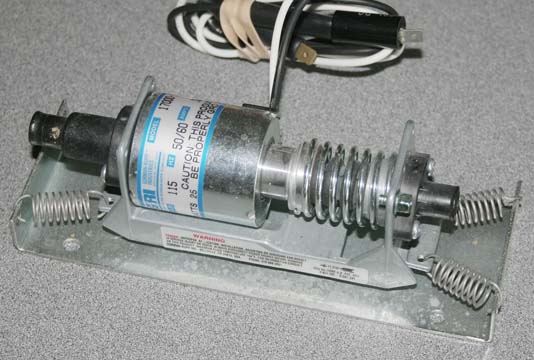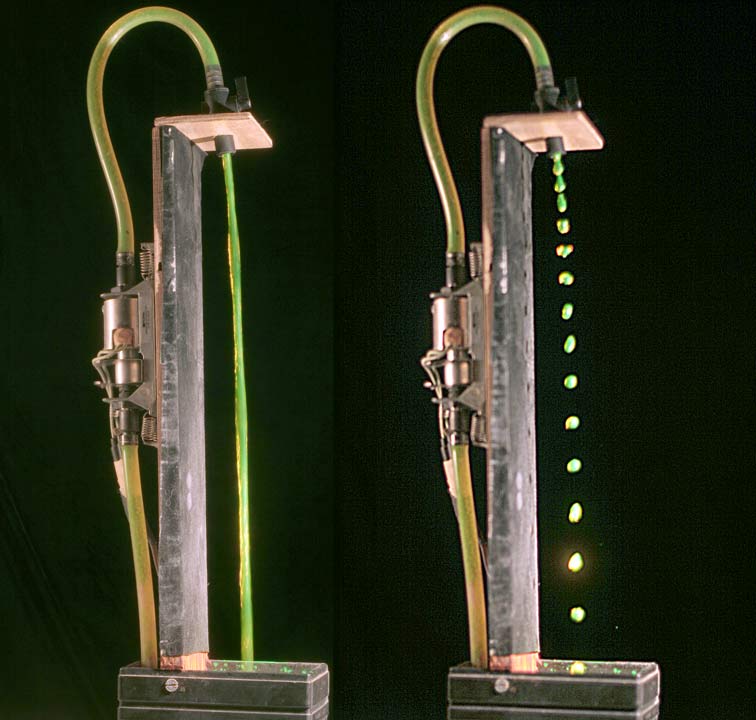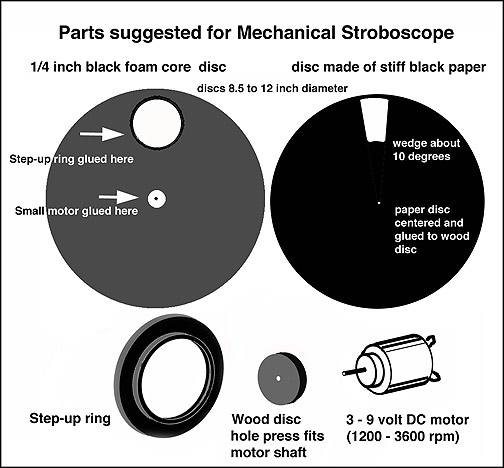|
The Harold "Doc" Edgerton Piddler
Andrew Davidhazy
School of Photo Arts and Sciences Rochester Institute of Technology back to list of articles page Harold Edgerton is well known for his tremendous contributions to the field of high sped photography and the electronic flash and the stroboscope. Find a copy of his book "Electronic Flash, Strobe" (available from MIT Press) to read about his work. One of the demonstrations he invented in order to bring the topic of stroboscopy to a level that the average person would identify with was a device he called "The Piddler". This device essentially was a fountain powered by a diaphragm or oscillating pump. Such a pump delivers small "packets" of liquid at its exit nozzle tied in to the frequency of the power supply. When driven by 110 volts 60 Hz AC the nozzle delivers 60 droplets every second. These are produced so rapidly that to the unaided eye the exiting droplets appear to form steady stream of liquid as if a water faucet had been opened at someone's home. But this is not the case. To visualize what the diaphragm pump delivers some device is needed that will allow us to perceive how the drops are formed and how they change as the depart from the pump's nozzle. Because the pump operates in a regular, repeatable, fashion the instrument of choice for this visualization is, as you guessed it, stroboscope. Stroboscopes are merely devices that either produce short duration bursts of light at repeatable, usually adjustable, intervals or devices that interrupt our vision of the object being studied in a periodic basis. The former, light producing, stroboscopes are available commercially from a variety of sources. Those that are employed for technical purposes tend to be expensive and I will not devote more to them at this time. A company that made a noteworthy light flashing stroboscope was General Radio. Especially their 1531A model which probably sits sadly languishing in many an equipment storeroom. Getting back to the Piddler. The pump that makes the Pidddler possible is one such as the Gorman Rupp Industries , Bellville, OH model 17000-001. They have a website at http://www.gripumps.com/ but their pumps are sold by distributors and you'll have to find one in your neighborhood.  The Piddler consists of the pump, typically attached to some vertical holder, tubes that extend from the intake and the exit nozzle and a basin that holds the liquid to be pumped. The layout of the parts as I set them up is shown in the photograph below. The pump is attached to the back side of a board and has a tube extending into the tub below. The board, attached to the tub on both sides, has holes drilled into it to allow the liquid to move from the front division to the back. In this photograph you can see the "action" both as it is perceived by the unaided eye and with continuous, tungsten, illumination and as seem with a stroboscope. The view would be the same whether a light stroboscope or a "mechanical" stroboscope is used to view the stream  The advantage of a calibrated and variable rate light flashing stroboscope is that the view can be simultaneously perceived by a surrounding audience whereas the mechanical one usually can only be seen by one or two people at a time. In this case the water in the catch basin had a small amount of fluorescein added to make the drops more striking. The bead of drops is suitable for visual examination and explanation and probably serves as a conversation piece to start off many discussions related to gravity, shape alliteration, the effect of synchronous and unsynchronous operation of the stroboscope on slow motion visualization. As for the mechanical stroboscope. I have a complete article on how to make one but basically here is a drawing of parts making up such a low-tech but very powerful motion analysis stroboscope. The link to the article is HERE  This mechanical stroboscope powered by a variable DC source can be used to visualize the droplets as they leave the nozzle and fall to the catch basin below. The article describes one method applicable to attaching the device to a camera lens and making photographs with it but just by itself the rotating disk makes a simple demonstartion quality "instrument". One can simply look through the hole in the 1/4 inch foamcore. Lacking a variable voltage power suppky I would suggest you just try it with a 9 volt batery. Or bateries of other voltages. Or with an adjustabe voltage battery "eliminator". These provide 9, 7.5, 6, 4.5 and 3 volts generally. When the slotted disk is turning at the same rate (or a whole fraction of) that the drops are being generated a string of stationary drops will seem to hang in mid air. AMAZING! When the rotation rate is unsynchronized with the rate of drop production the beads of drops will either appear to gradually move downwards if the rotation rate is less than the drop generation rate or upwards and defying gravity when the rotation rate is greater then the drop generation frequency. The reason for the above behavior is that when the two are synchronized every time the slot passes our eyes a drop appears in a particular spot in space. When the slot passes our eyes again, the drop that was above the previous one moves one position down and so on. Because at a given distance from the nozzle all drops have roughly the same shape we tend to perceive this as the same drop just hanging and vibrating in one spot. It helps to remember that at any given spot there are 60 new drops in that location every second or 3600 every minute. The time between drops is 1/60 second and is given by the pumping frequency of the pump which is tied to the AC line. It is seen that at the top, or close to the exit nozzle the distance between drops is small. As they accelerate he distance grows larger as they move more quickly. You may also notice that there are significant changes in drop shape close to the top. These continue as one proceeds downwards but the changes are more gradual. A stroboscope allows us to visualize high speed repetitive events such as the operation of this pump and ejected liquid or in applications where such motion is found. This could be in the printing plant, in textile mills, in punch press manufacturing plants, etc. The applications are many. An interesting variation of the single nozzle Piddler is the one where the exit tube is split in two via a "Y" connection and then drops are ejected from two nozzles simultaneously. The two streams or sets of drops can then be made to interact and interact with each other. Because Nature so cooperative interesting interactions between the two stream can be visualized. You may be surprised at the result. Try it! If you
found this article of interest and wish to communicate with me drop me
an email at andpph@davidhazy.org
|